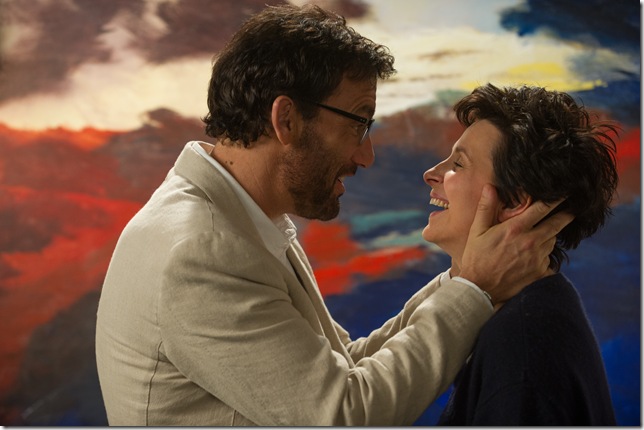Having been raised in the drudgery of our non-airbrushed public school system and not in the Hollywood fantasy of a freewheeling private school, I couldn’t relate much to the milieu of Words and Pictures, a rival-teachers dramedy set in a mythical world of privileged academia. It’s the kind of environment where syllabi, curricula and sensible grades are jettisoned, if they ever existed in the first place, at the service of rogue teachers whose assignments are dictated by the zeitgeist in the building.
This applies equally to Jack Marcus (Clive Owen) — an English professor of former renown who has fallen into a creative rut, taken to the bottle, and resigned himself to an unfulfilling life of teaching Updike to disinterested pupils — and Dina Delsanto (Juliette Binoche), a painter of current renown whose debilitating rheumatoid arthritis has led her to relocate from New York to the heartland for a teaching job.
Enemies from their first encounter in the teacher’s lounge, these inevitable love interests promptly launch a feud that begins in their respective courses and soon percolates through the halls: Which is better, words (Jack’s purview) or pictures (Dina’s field)? Most of the schoolwork revolves around this subject, leading up to a “Words Vs. Pictures” battle in the school’s auditorium.
With all of our metaphoric wars raging in this country, from the War on Drugs to the War on Women to the War on Coal (ha) to the War on Poverty (if only), this movie’s war seems an especially provincial and silly one, hardly worthy of discussion in a serious institution. After all, the film itself, like virtually all motion pictures since the development of synchronized sound, is proof that, like Sinatra’s croon of “love and marriage,” you can’t have one without the other. It’s only a matter of time before the faculty and students arrive at this pedestrian revelation.
At any rate, the conflict ignites a new fire within Jack, and also brings him closer to Dina, who frequently swats him away like a pesky insect until his rakish charms win her over — when he’s not drinking, that is. Jack’s alcoholism, which threatens his future at the school, becomes the movie’s emotional anchor, the writhing core underneath its rom-com patina.
And as far as sobriety dramas go, Words and Pictures is not bad. Owen believably struggles with the disease, and he captures Jack’s combustible personality — both his inspiring Dr. Jekyll and his destructive Mr. Hyde. Binoche, who contributed her own striking, abstract paintings to the movie, brings wit and inhibition to Dina, playing the headstrong, powerful female lead with echoes of Barbara Stanwyck and other man-eaters of a certain vintage.
The couple’s effective chemistry, along with a literate screenplay that name-drops difficult authors, might help sell Words and Pictures as a cerebral art-house movie for grown-ups. But it’s really Hollywood-lite, with its meager desire for mainstream acceptance exposed by a transparently unconvincing ending. Despite its bevy of nine- and 10-syllable words rarely uttered in a mass-market entertainment, Words and Pictures slips into a formula so common that it wouldn’t pass creative muster with either its tough wordsmith or its exacting artist.
WORDS AND PICTURES. Director: Fred Schepisi; Cast: Clive Owen, Juliette Binoche, Bruce Davison, Amy Brenneman, Keegan Connor Tracy; Distributor: Roadside Attractions; Rating: PG-13; Playing now at AMC Aventura, Regal South Beach 18 and AMC Sunset Place 24; opens Friday at Living Room Theaters and Regal Shadowood in Boca Raton and Movies of Delray in Delray Beach.
